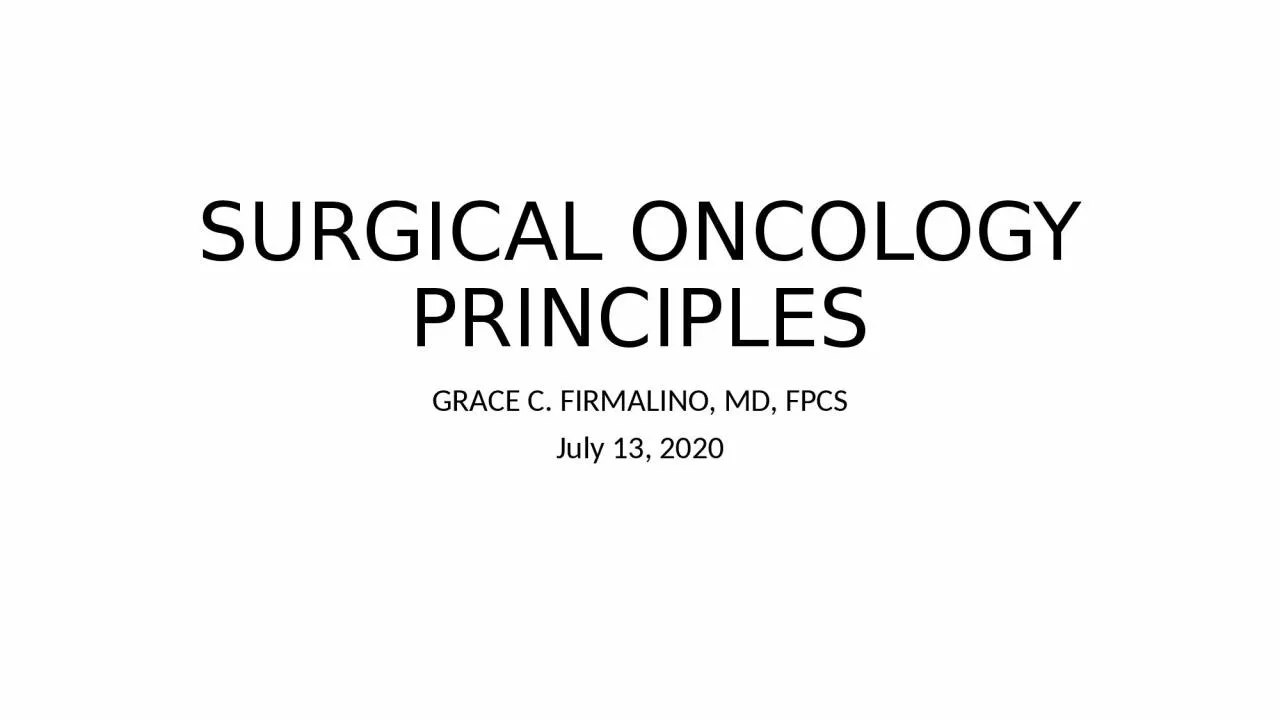

GRACE C FIRMALINO MD FPCS July 13 2020 ONCOLOGY A branch of medicine concerned with the prevention diagnosis treatment and study of cancer Primary or definitive surgical therapy en bloc resection of tumor with adequate margins of normal tissues and regional lymph nodes with local an ID: 1033177
Download Presentation The PPT/PDF document "SURGICAL ONCOLOGY PRINCIPLES" is the property of its rightful owner. Permission is granted to download and print the materials on this web site for personal, non-commercial use only, and to display it on your personal computer provided you do not modify the materials and that you retain all copyright notices contained in the materials. By downloading content from our website, you accept the terms of this agreement.
1. SURGICAL ONCOLOGY PRINCIPLESGRACE C. FIRMALINO, MD, FPCSJuly 13, 2020
2. ONCOLOGYA branch of medicine concerned with the prevention, diagnosis, treatment and study of cancer Primary (or definitive) surgical therapy – en bloc resection of tumor with adequate margins of normal tissues and regional lymph nodes with local and regional control as primary goalAdjuvant therapy – radiation therapy, systemic therapy (chemotherapy, immunotherapy, hormonal therapy, biologic therapy) where goal is systemic control by treatment of distant foci of subclinical disease to prevent distant recurrence
3. CANCER BIOLOGYESSENTIAL ALTERATIONS THAT DICTATE MALIGNANT GROWTHSelf-sufficiency of growth signalsInsensitivity to growth-inhibitory signalsEvasion of apoptosisPotential for limitless replicationAngiogenesisInvasion and metastasisReprogramming of energy metabolismEvading immune destructionTargets for cancer therapy
4. ETIOLOGYGENETIC FACTORSENVIRONMENTAL FACTORSCHEMICAL CARCINOGENSPHYSICAL CARCINOGENSVIRAL CARCINOGENS
5. CANCER GENOMICSAccumulation of genomic alterations leading to selection of cells with increasingly aggressive behaviorOncogenes – gain of functionTumor-suppressor genes – loss of functionSomatic mutations – acquired gene alterationsAbout 90% of cancer genes are mutated at the somatic or tumor levelGermline mutations - inherited
6. Hereditary CancersTumor development at a much younger age than usualPresence of bilateral diseasePresence of multiple malignanciesPresentation of a cancer in the less affected sexClustering of the same cancer type in relativesOccurrence of cancer in association with other conditions such as mental retardation or pathognomonic skin lesions
7. Genes Associated with Hereditary CancerBRCA1 – Hereditary breast-ovarian cancer syndromeBRCA2 – Hereditary breast-ovarian cancer syndromep53 (tumor protein 53) – Li-Fraumeni Syndrome (breast, soft tissue sarcoma, osteosarcoma, brain tumors)APC (adenomatous polyposis coli gene) – Familial adenomatous polyposis (colorectal, gastric, duodenal, periampullary, hepatobiliary)MEN1 – multiple endocrine neoplasia (pancreatic islet cells, parathyroid adenoma, pituitary adenoma, carcinoid)
8. Hereditary cancer genesBRCA1, BRCA 2 – hereditary breast-ovarian cancer syndrome10% of early-onset breast cancer (age 40 years or younger)First- or second-degree relative with premenopausal breast cancer or ovarian cancer at any ageRisk of developing breast and ovarian cancer by age 70BRCA 1 – 87% and 44% BRCA 2 – 84% and 27%Increased risk for other cancers Colon, prostate (BRCA1)Prostate, gallbladder and bile duct, pancreas, stomach, malignant melanomaBRCA 1 – estrogen receptor negative tumorsBRCA 2 – estrogen receptor positive tumors
9. ENVIRONMENTAL FACTORSCHEMICAL CARCINOGENSSoot – skin, lungAflatoxin – hepatocellular carcinomaCoal-tar pitches – lungFormaldehyde – nasopharynxPHYSICAL CARCINOGENSChronic inflammationNon healing wounds - skinH. pylori infection – gastricOpisthorchis – cholangiocarcinomaAsbestos – lungRadiation – skin, thyroid
10. ENVIRONMENTAL FACTORSVIRAL CARCINOGENSHepatitis B and C – hepatocellular carcinomaEpstein-Barr virus- nasopharyngeal carcinomaHuman papillomavirus 16 and 18 – cervical, vulvar, vaginal, penile, anal
11. CANCER SCREENINGEarly detection using relatively noninvasive tests for early diagnosis and more conservative surgical therapies with decreased morbidity and improved surgical cure and survival ratesDeveloped for general baseline-risk population
12. ACS recommendations for early detection of cancer in average-risk, asymptomatic individualsCANCER SITEPOPULATIONTEST OR PROCEDUREFREQUENCYBreastWomen age 40 and aboveMammographyAnnually for 45 to 54, biennial for 55 and aboveColorectalMen and women age 50 and aboveFOBTColonoscopyAnnual starting at 50Every 10 years starting at 50ProstateMen age 50 and aboveDRE and PSAAnnually
13. DIAGNOSISBiopsy – definitive diagnosisMucosal lesions – endoscopicallyPalpable lesions Fine needle aspiration biopsy – easy but does not give information on tissue architectureCore needle aspiration biopsy – more advantageous when histologic findings will affect therapyIncision biopsy – for very large lesions where definitive diagnosis cannot be made with needle biopsyExcision biopsy – made with curative intentDeep-seated lesions – image-guided (CT or ultrasound)
14. STAGINGDescribe the anatomic extent of a malignant process in an individualTumor size, location, extent, grade, dissemination to regional lymph nodes or distant sitesEssential for planning appropriate treatment for the patientTNM staging (clinical and pathologic) – microscopically confirmed malignant tumorsTumor – size of primaryNodes – presence or absence and extent of nodal involvementMetastasis – presence or absence and extent of distant metastases
15. SURGICAL MANAGEMENTCURATIVE SURGERY – remove primary tumor and draining lymphatics en blocINOPERABLE TUMOR –primary tumor cannot be resected with negative marginsPALLIATIVE SURGERY – improve quality of life by alleviating pain, infection or bleedingDISTANT METASTASES – surgery for isolated metastases has resulted in cure for selected cases
16. Treatment of cancer is multidisciplinary involving not just the surgeons and medical oncologists or radiation oncologists but pathologists, radiologists, reconstructive surgeons, primary care physicians.
17. REFERENCE: Schwartz’s Principles of Surgery 11th edition
18.